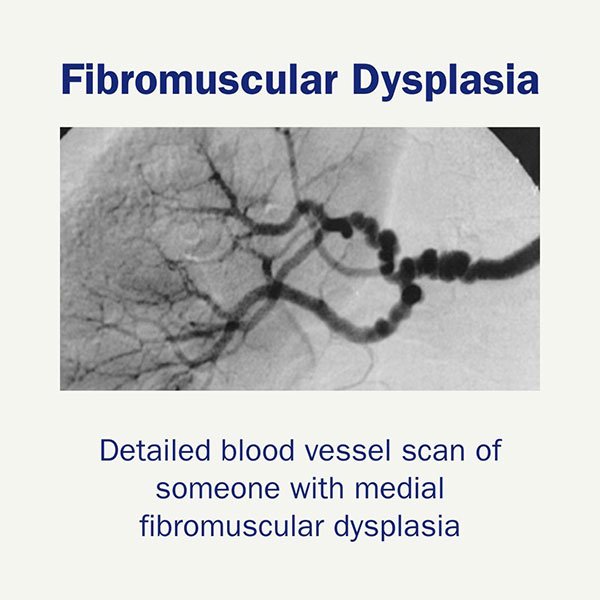Fibromuscular Dysplasia
Fibromuscular Dysplasia (FMD) is a medical condition that causes arteries to narrow, enlarge, or tear. FMD leads to other health problems depending on where and how it affects the arteries.
What is Fibromuscular Dysplasia?
Fibromuscular Dysplasia, commonly called FMD, is a disease that causes arteries to develop and grow abnormal cells inside the artery wall. The overgrowth of abnormal cells can cause parts of the arteries to narrow (stenosis), enlarge or “balloon” (aneurysm), or tear (dissection). Symptoms can vary depending on where FMD occurs or how it affects the arteries. It is important to note that FMD is different from atherosclerosis , which is a narrowing of the artery caused by plaque build-up. FMD is most commonly found in the arteries that supply the kidneys with blood (renal arteries) and the brain (carotid arteries).
Causes
Not much is known about the cause of FMD. Some studies have shown that hormones may play a role in the development of the disease. Other possible causes include: abnormal development of the arteries, the position or placement of arteries in the body, tobacco use, or taking certain medications.
Symptoms
Some people with fibromuscular dysplasia may not experience symptoms. Any signs and symptoms of FMD depend on which arteries are affected and if there is a narrowing, tearing, or enlargement in those arteries. For example:
If arteries in the kidneys become narrow or hardened, a person may develop:
High blood pressure
Poor kidney function
If the arteries connected to the brain are affected, symptoms may include:
Headache
Tinnitus (ringing in the ears)
Sudden neck pain
Dizziness
Stroke or a “mini-stroke” called a transient ischemic attack (TIA)
FMD can affect the mesenteric arteries (arteries that connect to the intestines), liver, and spleen, but this is usually less common. If FMD is found in these arteries, people may experience:
Abdominal pain after eating
Unexplained or unplanned weight loss
FMD in the arms and legs can lead to symptoms such as:
Limb discomfort or pain (especially after exercise)
Unequal blood pressures in the arms
FMD in the heart:
Spontaneous coronary artery dissection, or tearing of the coronary artery, especially in women that recently gave birth
Treatment
Unfortunately, there is no known cure for FMD. Recommended treatments are focused on managing FMD symptoms including medications for controlling blood pressure or alleviating headaches. In some cases FMD may require a surgical procedure, depending on how severe the condition is and where it’s located. It’s important to talk to your healthcare provider about which treatment plan is right for you.
Risk Factors
Smoking: Smoking is generally considered a significant risk factor for many vascular conditions. Tobacco use is connected to an increased risk of developing FMD.
Gender: Fibromuscular dysplasia has been found to be more common in people born as females than males.
Age: FMD can happen at any age, but is more common in people in their 50s.
Resources
Be The Voice For Patients Like You!
Vascular Cures is inviting patients and advocates to share their stories, advise on our programs, and help us advocate for patient needs. Patients as Partners is a community where patients are heard, empowered, and encouraged to impact the health system. Learn more and request more information here.


